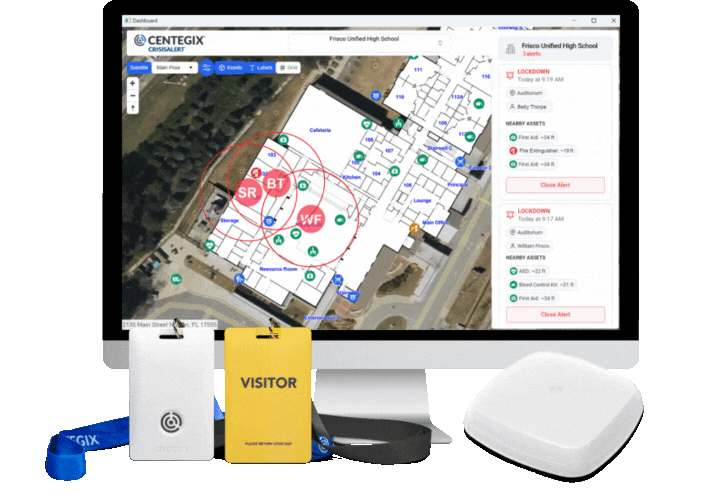Violence in healthcare isn’t just a growing concern—it’s a persistent crisis. Every day, frontline providers face risks that extend far beyond clinical care. From verbal assaults to physical attacks, the workplace has become a dangerous space for many healthcare professionals.
Nurses serving on the front lines of patient care are especially impacted, but they’re not alone. Physicians, technicians, executives—no one is immune. And yet, despite the rise in incidents, many healthcare organizations struggle to put meaningful solutions into place. The reasons are multifaceted—lack of awareness, underreporting, budget constraints, and competing priorities. But as Andrea Greco, Senior Vice President of Healthcare Safety at CENTEGIX, notes in a recent podcast with the American Hospital Association (AHA), there’s one truth we can’t ignore: “Making it a true priority to address workplace violence [starts] with allowing that to rise to the top.”
Below, we explore key takeaways from this thought-provoking episode of the AHA Associate Podcast, offering actionable insights for healthcare leaders ready to make safety a core value—not just a compliance checkbox.
The State of Violence in Healthcare
Over 60% of nurses report they are planning to transition out of their role in the next twelve months, with many citing safety concerns as a major reason.1 The Bureau of Labor Statistics reports that healthcare workers account for nearly half of all nonfatal injuries from workplace violence across U.S. industries.2 Yet too often, violence is brushed aside as “part of the job.” This outdated mindset creates apathy, erodes trust, and leads to dangerous levels of underreporting. As Greco points out, “Healthcare today sees so many competing priorities for time, attention, and resources. This has to be an organization-wide initiative to really gain steam.”
Three Common Barriers to Success
So what’s standing in the way of progress? In the podcast, Greco outlines three common barriers that hinder effective workplace violence prevention programs:
- Lack of Assessment
Many organizations don’t know where to start. Without conducting a thorough safety assessment tailored to their specific needs, they struggle to take meaningful action. Each facility is unique, and a one-size-fits-all approach won’t work. - Scattered Solutions
Safety initiatives often exist in silos. Some focus solely on training, others invest in technology, but few align these efforts under one cohesive strategy. A true workplace violence prevention program requires a layered approach—environmental design, policy, education, and active response tools. - No Plan for Continuous Improvement
Even well-intentioned efforts fall flat without a system for monitoring effectiveness. Organizations need data, reporting, and accountability mechanisms to assess what’s working, what’s not, and where to improve.
Where to Begin: Make Safety a Strategic Priority
Before you can launch a safety plan, you must set the tone at the top. Leadership buy-in isn’t optional—it’s the foundation of a thriving culture of safety. “This needs to be leadership-driven,” says Greco. “There needs to be both support and accountability across the organization.”
That includes:
- Clear policies and procedures
- Transparent communication with staff
- Investment in meaningful tools and training
- Visibility into incident data and response times
By making safety part of the organization’s DNA, healthcare leaders show their teams that their well-being is more than a talking point—it’s a commitment.
Creating a Layered Safety Plan
Greco urges organizations to think holistically and tailor their approach. “There’s no silver bullet,” she says. “It’s really about identifying your top areas to tackle and layering in solutions to meet those needs.”
A layered plan might include:
- Environmental modifications (e.g., secure access, weapons detection)
- Staff training on de-escalation techniques
- Wearable staff duress buttons, such as CENTEGIX CrisisAlert™
- Visitor management
Each layer reinforces the others, creating a stronger, more resilient safety net.
Technology That Empowers, Not Monitors
One of the most impactful tools discussed in the podcast is the CENTEGIX CrisisAlert™ system—a discreet, wearable duress button that allows any staff member to call for help immediately. Unlike Real-Time Location Systems (RTLS) that track employees continuously, CrisisAlert activates location data only when the user presses their alert button.
This distinction is critical. RTLS were implemented in hospitals to track assets, not people. Adapting them for staff safety introduces privacy concerns that often result in poor adoption. “We see a high adoption rate of our solution because we do not track employees all the time,” explains Greco. “Only when an alert is activated do we identify where help is needed.”
This privacy-first approach builds trust. It empowers staff to act without feeling surveilled, strengthening both psychological safety and response effectiveness.
The Ripple Effect: Safer Staff, Better Outcomes
Safety isn’t just a workforce issue—it’s a quality issue. Hospitals that prioritize workplace safety see benefits that ripple across the entire organization.
According to Greco, organizations that implement effective safety solutions often report:
- Increased staff satisfaction
- Higher adoption of safety protocols
- Better situational awareness and faster incident response
- More robust data to drive improvements
- Enhanced patient experiences and outcomes
In fact, 98% of CrisisAlert users say the wearable duress solution helps them feel safer and more supported at work. When employees feel protected, they’re more engaged, more loyal, and better able to focus on providing exceptional care.
Final Thoughts: Build a Culture of Safety
The takeaway is clear: building a culture of safety in healthcare starts with leadership and ends with empowerment. Organizations can’t afford to wait. Violence in healthcare is a growing threat that undermines care delivery, workforce retention, and financial performance.
By conducting honest assessments, aligning cross-functional teams, investing in the right tools, and communicating transparently, healthcare leaders can change the narrative from reactive to proactive.
Because when staff feel safe, everyone wins—patients, providers, and the organization.
Interested in learning how your organization can take the first step?
Explore the CENTEGIX Safety Platform® and request a demonstration from one of our Healthcare Safety experts.
1 AMN Healthcare. Nursing in Transition: Workplace Changes, Challenges and Solutions. 2025 Survey of Registered Nurses. 9th ed., AMN Healthcare, 2025. PDF file.
2 Bureau of Labor Statistics. “Table R12. Number of Nonfatal Occupational Injuries and Illnesses Involving Days Away from Work, Restricted Activity, or Job Transfer (DART), Days Away from Work (DAFW), and Days of Restricted Work Activity, or Job Transfer (DJTR) by Occupation and Selected Events or Exposures Leading to Injury or Illness, Private Industry, 2021-2022.” U.S. Bureau of Labor Statistics, 2023, https://www.bls.gov/iif/nonfatal-injuries-and-illnesses-tables/case-and-demographic-characteristics-table-r12-2021-2022.xlsx. Accessed 12 Mar. 2025.












